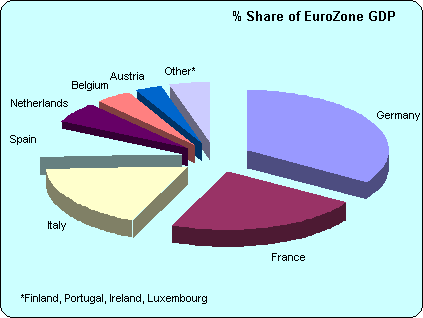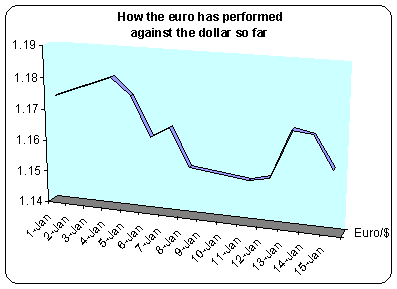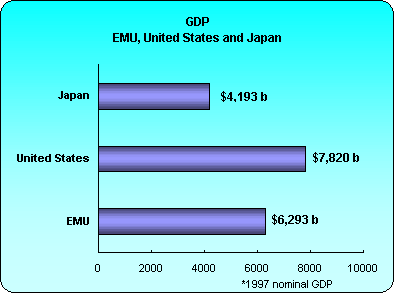The euro is here!
Anne D. Picker
International Economist
The original idea was developed shortly after the end of World War II as a political move (and it remains a political move even though the impact will be economic). The goal was to link the European countries so closely that another war would be impossible. But political unity proved to be difficult with countries refusing to give up their national sovereignty. Political union would have meant a common government budget, foreign affairs and social policy. However, monetary union allows countries to have control over their national budgets. At the same time, the countries acknowledge that under monetary union it will be more difficult to solve long term internal problems such as unemployment under the European Economic and Monetary Union (EMU) constraints.
In a way, the euro's birth can be looked upon as a solution to the problem caused by the breakdown of the Bretton Woods system of fixed exchange rates in 1971-73. Because of the high level of trade between European countries, it was felt that freely floating exchange rates would be disruptive to commerce and economic growth. Countries attempted to peg their currencies to one another to limit fluctuations. However, because of the lack of economic convergence, periodic realignments were necessary and the countries drifted into two blocks - one with low inflation and low interest rates and another that required higher interest rates to maintain stable exchange. There were still disruptions.
The European Economic and Monetary Union launch is expected to have a major impact on the world economy, international trade relations and global financial markets. The "EuroZone" or "euroland" includes 11 European nations and will eventually rival the size of the U.S. economy as well as U.S. trade volumes. The eleven countries are Germany, France, Belgium, Luxembourg, Finland, Italy, Spain, Portugal, Ireland, Netherlands and Austria. Four members of the Economic Union (EU) chose not to participate in EMU. Denmark, Sweden, and the United Kingdom did not join at this time because of strong domestic and political opposition. Greece did not meet the inflation target set for entry to the EMU, but is working towards the next possible entry date in 2001.

The EuroZone uses a single currency and pursues a single monetary policy. Within the EuroZone, there is no longer a currency risk - member currencies are irrevocably linked at fixed rates to the euro. It is expected that the cost of doing business will decline and encourage output, trade, and investment growth.
In compliance with the rules set down during the evolution of the EMU, final and irrevocable conversion rates between the euro and each participating currency were announced amid much pomp on December 31, 1998. The rates listed below are the only rates that will be used for conversion. In addition to the rates for the EMU 11, reference rates were calculated for the United States, United Kingdom, Japan and Switzerland.
| Reference rates for euro countries are irrevocably set - | |
| Units of currency Per Euro | |
| Austrian schilling | 13.7603 |
| Belgium/Luxembourg franc | 40.3399 |
| Finnish markka | 5.94573 |
| French franc | 6.55957 |
| German d-mark | 1.95583 |
| Irish pound | 0.787564 |
| Italian lira | 1936.27 |
| Dutch guilder | 2.20371 |
| Portugese escudo | 200.482 |
| Spanish peseta | 166.386 |
| Other reference rates - | |
| U. S. dollar | 1.1790 |
| Japanese yen | 130.96 |
| UK sterling | 0.71220 |
| Swiss franc | 1.6123 |
| One of the unexpected impacts of the euro's launch is the inability of the 11 nations to harmonize days off for Europe's newly integrated exchanges and financial institutions. Only two have been agreed upon - Christmas and New Year's Day. The reduction of bank holidays will be especially painful to the French who celebrate 15 days each year compared with eight in Britain and six in the United States. |
Interest rates throughout the EMU have gradually converged, sinking down to Germany's low rates. EuroZone short term interest rates have been pegged at three percent throughout all 11 nations. Differences in long term interest rates will reflect the varying levels of risk across countries.
Euro benefits to member countries
Expectations are high that the euro will provide the catalyst for the revitalization of the continent's capital markets. Minimally, the euro has provided a shakeup in stock market and financial institution operations.
- The euro will provide currency stability through its system of fixed foreign exchange rates.
- Businesses and individuals will save foreign exchange uncertainties and transactions costs by doing business in one currency.
- Transparent pricing will increase competition because it will be easier for companies to sell across the EuroZone and for consumers to find the best price.
- The euro gives a boost to the development of a liquid eurowide capital market. The euro lowers the cost of capital and improves its allocations. Smaller companies, which in the past relied on backward, more expensive domestic banks should be able to finance more efficiently because of a greater choice of financing sources and the competition among them.
- Investors and pension funds should have a wider choice of securities at more competitive prices.
- Euro will boost all trade.
| According to an article in the Financial Times, new car dealers were busy putting euro price stickers on autos within the EuroZone. However these price tags merely emphasized the wide price disparities between individual EMU countries. Prices vary up to 25 percent among countries in the EU and up to 50 percent when the EU 11 is compared to the United Kingdom. With exchange rates no longer a factor, two reasons are given to explain the gap. The first is greatly differing specifications for similar cars. The second is the wide divergence of tax rates on new car purchases - up to 213 percent in Denmark and as low as 15 percent in Luxembourg. It is expected that euro pricing will lead to consumer pressures that will substantially narrow the price gaps by making them transparent, at least at the pretax level. It is expected that within two years, prices will have converged to such an extent that there will be no reason to cross internal EU borders in search of a better deal. |
The schedule calls for euro to be phased in gradually. At present it is being used as "virtual money" for some credit card purchases, denominating stock prices, for international transactions and for paychecks in some multinational firms. Many very large international firms (other than financial institutions) have already switched to the euro to do business although it is not yet required. It is expected that smaller firms will be forced to follow suit because their larger clients will demand it.

European Central Bank Structure
The European Central Bank (ECB) will decide monetary policy and national central banks (i.e. the Bundesbank, Bank of France, etc.) will implement it. Together they form the European System of Central Banks (ESCB). The president is Wim Duisenberg, a former governor of the Dutch central bank, who will serve an eight year term.
The ECB's prime objective is to maintain price stability through interest rate policies. The ECB will make decisions on interest rates by majority vote of its governing council as does the Bundesbank and the Federal Reserve. The council meets every other Thursday - just as the Bundesbank does. The main monetary instrument is the repurchase rate (repo), which has been set at three percent.
The ECB has adapted two policy guides -
- a monetary target, or more precisely a reference value;
- an inflation target of 2 percent or less.
To monitor its performance against the inflation target, the ECB will use a basket of economic indicators including an inflation forecast. Given the concerns about reliability of the data, this flexibility may make sense but also could cause confusion in financial markets.
The ECB has no history or track record and will need to establish its own anti-inflationary record and credibility. Eleven of the 17 members of the governing council represent the national central banks. In contrast only five of the 12 members of the U.S. Federal Reserve Open Market Committee are from district reserve banks. Some worry that this decentralization could weaken the ESCB. The governing council is supposed to set interest rates according to conditions in the whole euro area, but there is a risk that national governors will be unduly influenced by conditions in their home country.
Maximum transparency of ECB operations could go a long way to solve some of the problems. But the ECB has shown that it prefers to hide behind a veil of secrecy. It will not publish the minutes of its policy meetings, its inflation forecast against which its actions could be judged, or the details of how members vote.
The ECB is considered to be the most independent central bank ever. The Maastricht Treaty prohibits it from taking orders from politicians. Members of the executive board are appointed for eight year nonrenewable terms to insulate them from pressures to please politicians in order to get reappointed.
The ECB's formal accountability to elected politicians or to the public is more limited than that of other central banks. There is no clear institutional context within which the ECB can answer for its actions. The danger is that without proper accountability it will find it much harder to win the kind of public support enjoyed by the Bundesbank and the Federal Reserve. There are already signs that some politicians will be quick to blame the ECB for all kinds of economic ills such as high unemployment.
The political shift to the left across the EU, and especially in Germany, will present challenges. The newly elected governments want to expand the ECB mandate to include growth as well as inflation. They also want more expansionary fiscal policy to make room for their socialist policies. Friction between EU politicians and the ECB is already intensifying as European economic growth slows.
A major hurdle for the EMU is that member countries are at different stages of the economic cycle. This could cause problems for the ECB because interest rates as set by the ECB will not satisfy all 11 countries. For example, Ireland, Spain and Portugal are experiencing higher growth rates than those of Germany and France. The bank's interest rate policy will be tested as the German economy and others experience slower growth in the year ahead and demands for policies to alleviate unemployment become more vocal. The current interest rate policy could end up being a part of a destabilizing and unsustainable mix of loose fiscal and tight monetary policies. Blame would be placed on the ECB for exacerbating unemployment while the bank would blame governmental structural and social rigidities in member countries.
| A comparison of three market zones - | |||
| EuroZone | United States | Japan | Total Area (square kilometers) | 2364 | 9373 | 378 |
| Population (Million, average 1998) | 292 | 270 | 127 |
| GDP (98 Ecu at market prices) | 5774 | 7592 | 3327 |
| GDP (annual % change 98/97) | 3.0 | 3.3 | -2.5 |
| Inflation (annual % change Nov 98/Nov 97) | 0.9 | 1.5 | 0.8 |
| Trade Balance | 89.4 | -186.1 | 72.7 |
| Industrial Production Growth (97/96) | 4.1 | 4.9 | 3.7 |
| Unemployment (Oct 98) | 10.8 | 4.5 | 4.3 |
| 3 month short term interest rate (% Oct 98) | 3.7 | 5.2 | 0.7 |
| 10 year govt bond yield (Nov 98 nominal %) | 4.3 | 4.8 | 1.1 |
| Source - Eurostat | |||
Fiscal policy
In the absence of independent monetary and exchange rate policy, the only tool left to individual countries is fiscal policy. A Stability and Growth Pact, which puts tight limits on public borrowing, is part of the EMU plan. The logic behind the Pact was to prevent the use of fiscal policy to undermine monetary policy. But if the complicated Pact rules are followed, fiscal policy could become dangerously tight. It should be noted that one of the criteria for entrance into the EMU was that the government deficit should be no more than three percent of GDP per year and the debt level be not more than 60 percent of GDP. It should be noted that the euro governments taken together breached the three percent ceiling every year between 1982 and 1996.
Financial Markets
Bonds
Investors can look forward to a broadening of the corporate bond market in 1999 according to analysts. While everyone agrees that issuance will grow, there are differences in opinion about the rate of growth. Convergence in Europe's government bond markets and three percent interest rates mean that many investors will be nudged into corporate bonds for the first time. The scenario is compelling for companies with euro liabilities to lock into low rates on a long term basis. Bond markets are expected to have more depth and greater sophistication. For example, junk bonds are a developed market in the United States while in Europe it is still a fledgling business. While interest rates are much the same throughout the EuroZone, the risks between countries are not and bonds will still be judged on the creditworthiness of the issuer.
Equities
On January 4th all stock prices on bourses in the 11 member countries were converted into euros. Even though Britain is not a member, European firms' stock trading on the London Stock Exchange is now quoted in euros. Exchange officials can change rules to allow some British stocks to trade in euros at company request.
The stock selection process is undergoing a massive change on the continent. Focus is shifting from the economic wellbeing of the geographic location to sectoral analysis of the company's industry and business. Investors no longer will have to factor in foreign exchange risks and will be able to concentrate on the fundamentals for the stock and the industry.
Keeping up with economic trends
Eurostat, founded in 1953, is the statistical agency for the EU and ECB. It is located in Luxembourg and its primary function is to provide up to date data for the EU. The aim is to create common classifications, methods and organizational structures for compiling comparable statistics for EU member states. These data provide the basis for the ECB's inflation analysis. The national statistics offices provide the domestic data input for Eurostat according to a uniform set of rules. Eurostat then consolidates and harmonizes the data taking into account the specific character of each country. The national statistics services continue to calculate their own national indicators using their own methodology as well.
The most watched series is the harmonized Consumer Price Index. This is the inflation rate targeted by the ECB for policy making. National CPI rates, which differ from the harmonized rate continue to be calculated. However, over time they are likely to lose their immediate policy implications. For now, there is bound to be interest in the data's relative dispersion. Strong variations between countries in inflation indices, for example, could point towards stress within the EuroZone.

What does it mean to U.S. investors?
Besides offering political and economic stability to U.S. investors as discussed above, the euro should make it easier and less expensive for American companies to sell their products and services in the EuroZone. By eliminating fluctuating exchange rates, the euro should create competitive pressures in Europe that will narrow price variations among countries. That should favor cost conscious American companies who already have cut costs through restructuring.
In a broader sense, if the euro is successful, it can pose a threat to the dollar's supremacy and dominance as the world's primary reserve currency. If the euro is unsuccessful, it could the endanger the progress made by Europe in melding its diverse economies into a single market and subduing historical hatreds with the help of economic engineering. A major concern is that Europe could turn inward while much of the world is still struggling to recover from the Asian financial crisis.
In short, if the euro works, Europe will be stronger and more prosperous. If it doesn't, it will be poorer and more divided.